Master's Dissertation: Sustainability and Disaster Resilience in Oman
VerifiedAdded on 2022/08/12
|80
|20185
|305
Thesis and Dissertation
AI Summary
This Master's dissertation examines the crucial intersection of sustainability and disaster resilience within the Sultanate of Oman, focusing on the challenges posed by both natural and human-made disasters. The study investigates the vulnerability of Oman to various hazards, including cyclones and earthquakes, while also addressing the country's geographical location and its impact on disaster occurrences. The research delves into the need for proactive planning and the integration of scientific knowledge into urban infrastructure and developmental planning to mitigate human and property losses. The dissertation provides an overview of disaster risk reduction strategies and the importance of disaster resilience for sustainable development, analyzing Oman's current practices and suggesting improvements. It also explores the role of governance and mainstreaming disaster risk reduction in development, emphasizing the need for a balanced approach to economic, environmental, and social well-being to achieve sustainable development goals.
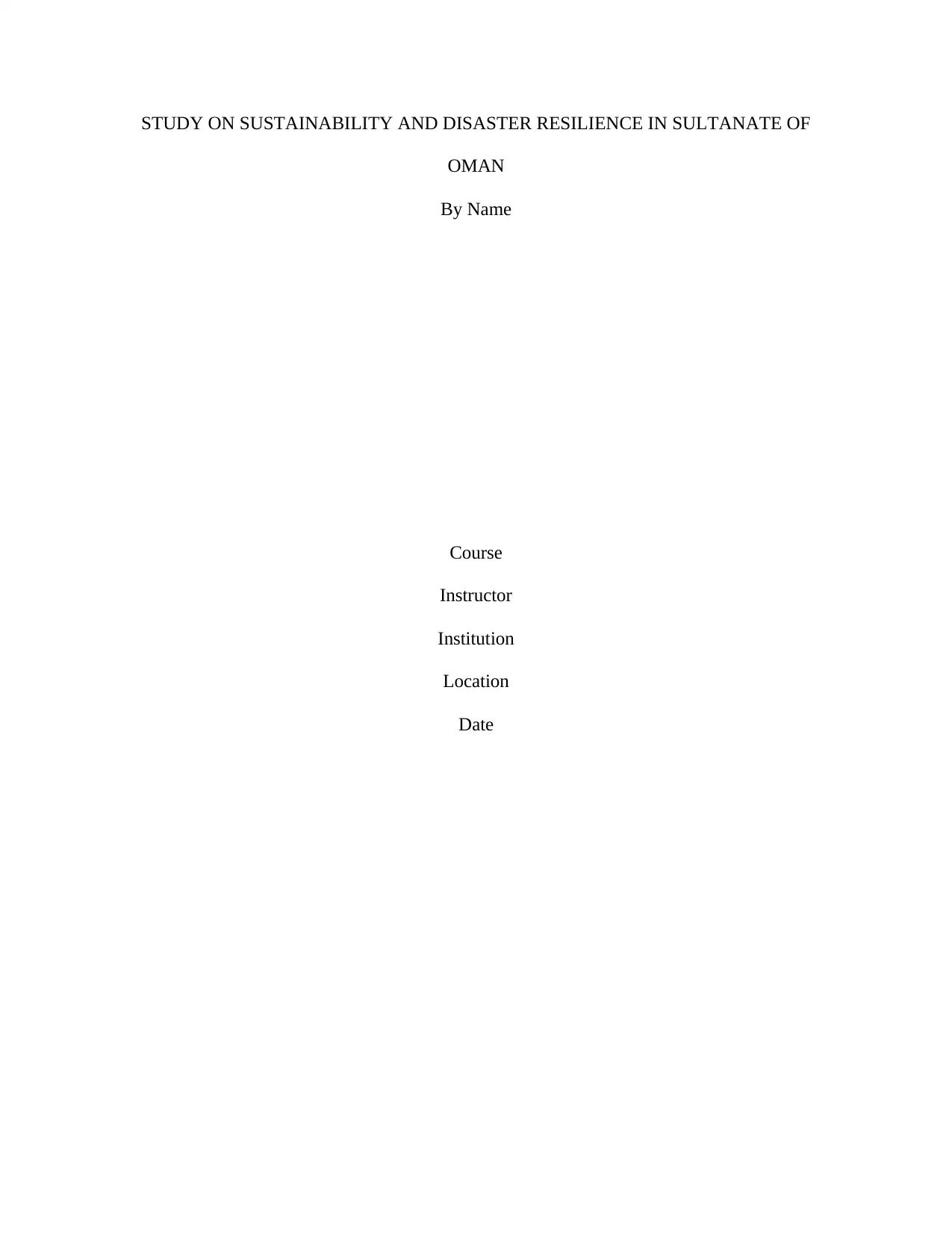
STUDY ON SUSTAINABILITY AND DISASTER RESILIENCE IN SULTANATE OF
OMAN
By Name
Course
Instructor
Institution
Location
Date
OMAN
By Name
Course
Instructor
Institution
Location
Date
Paraphrase This Document
Need a fresh take? Get an instant paraphrase of this document with our AI Paraphraser
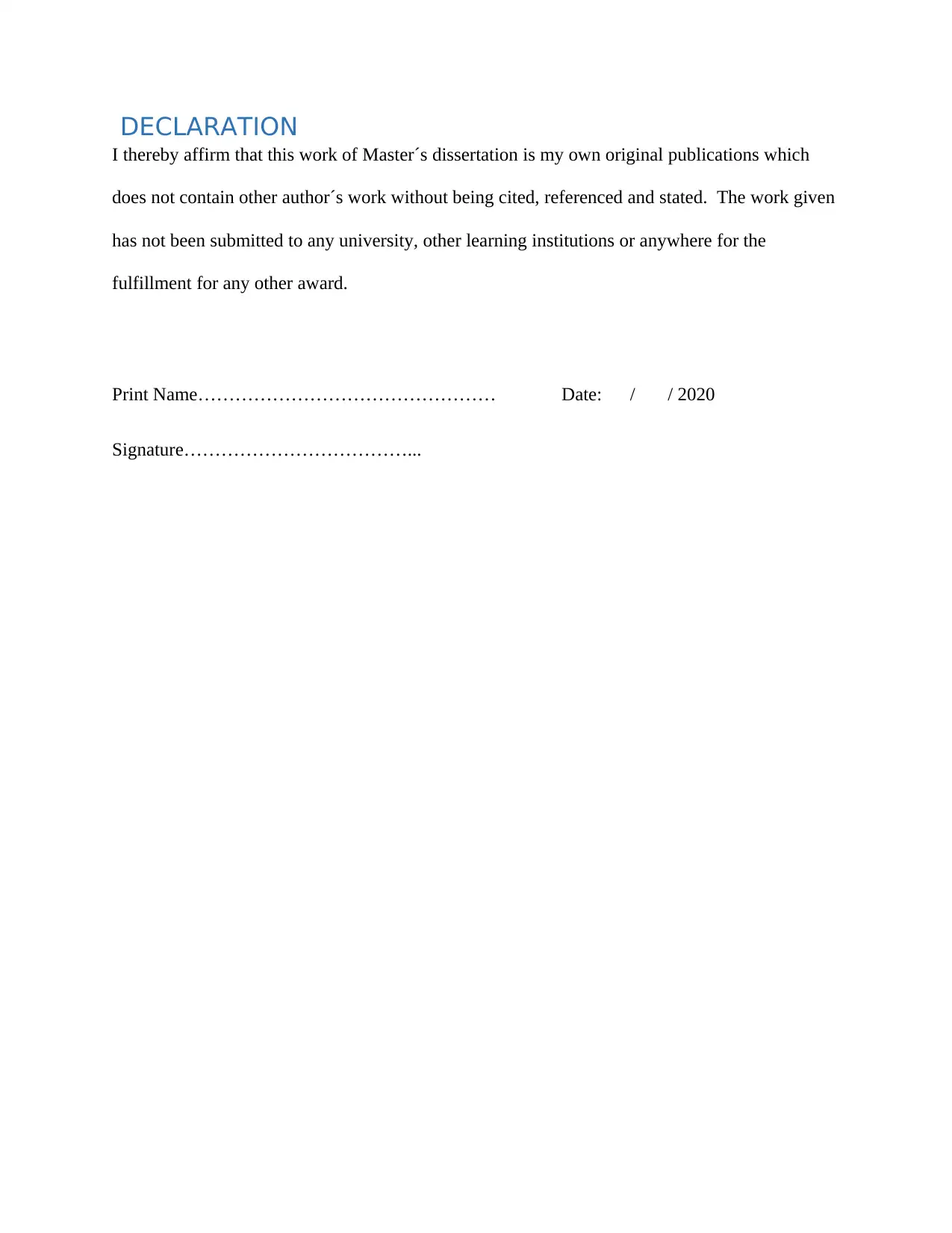
DECLARATION
I thereby affirm that this work of Master´s dissertation is my own original publications which
does not contain other author´s work without being cited, referenced and stated. The work given
has not been submitted to any university, other learning institutions or anywhere for the
fulfillment for any other award.
Print Name………………………………………… Date: / / 2020
Signature………………………………...
I thereby affirm that this work of Master´s dissertation is my own original publications which
does not contain other author´s work without being cited, referenced and stated. The work given
has not been submitted to any university, other learning institutions or anywhere for the
fulfillment for any other award.
Print Name………………………………………… Date: / / 2020
Signature………………………………...
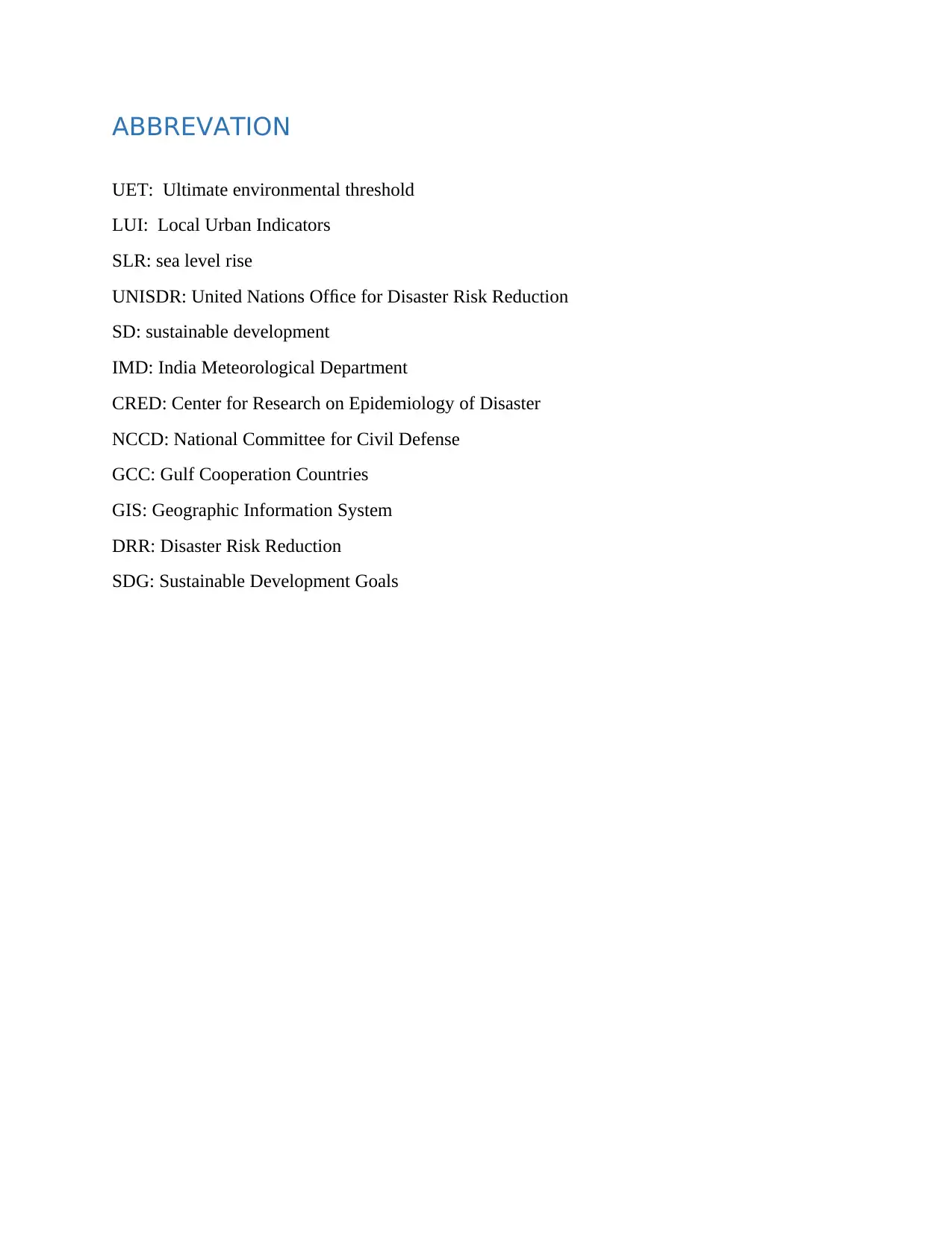
ABBREVATION
UET: Ultimate environmental threshold
LUI: Local Urban Indicators
SLR: sea level rise
UNISDR: United Nations Office for Disaster Risk Reduction
SD: sustainable development
IMD: India Meteorological Department
CRED: Center for Research on Epidemiology of Disaster
NCCD: National Committee for Civil Defense
GCC: Gulf Cooperation Countries
GIS: Geographic Information System
DRR: Disaster Risk Reduction
SDG: Sustainable Development Goals
UET: Ultimate environmental threshold
LUI: Local Urban Indicators
SLR: sea level rise
UNISDR: United Nations Office for Disaster Risk Reduction
SD: sustainable development
IMD: India Meteorological Department
CRED: Center for Research on Epidemiology of Disaster
NCCD: National Committee for Civil Defense
GCC: Gulf Cooperation Countries
GIS: Geographic Information System
DRR: Disaster Risk Reduction
SDG: Sustainable Development Goals
⊘ This is a preview!⊘
Do you want full access?
Subscribe today to unlock all pages.

Trusted by 1+ million students worldwide
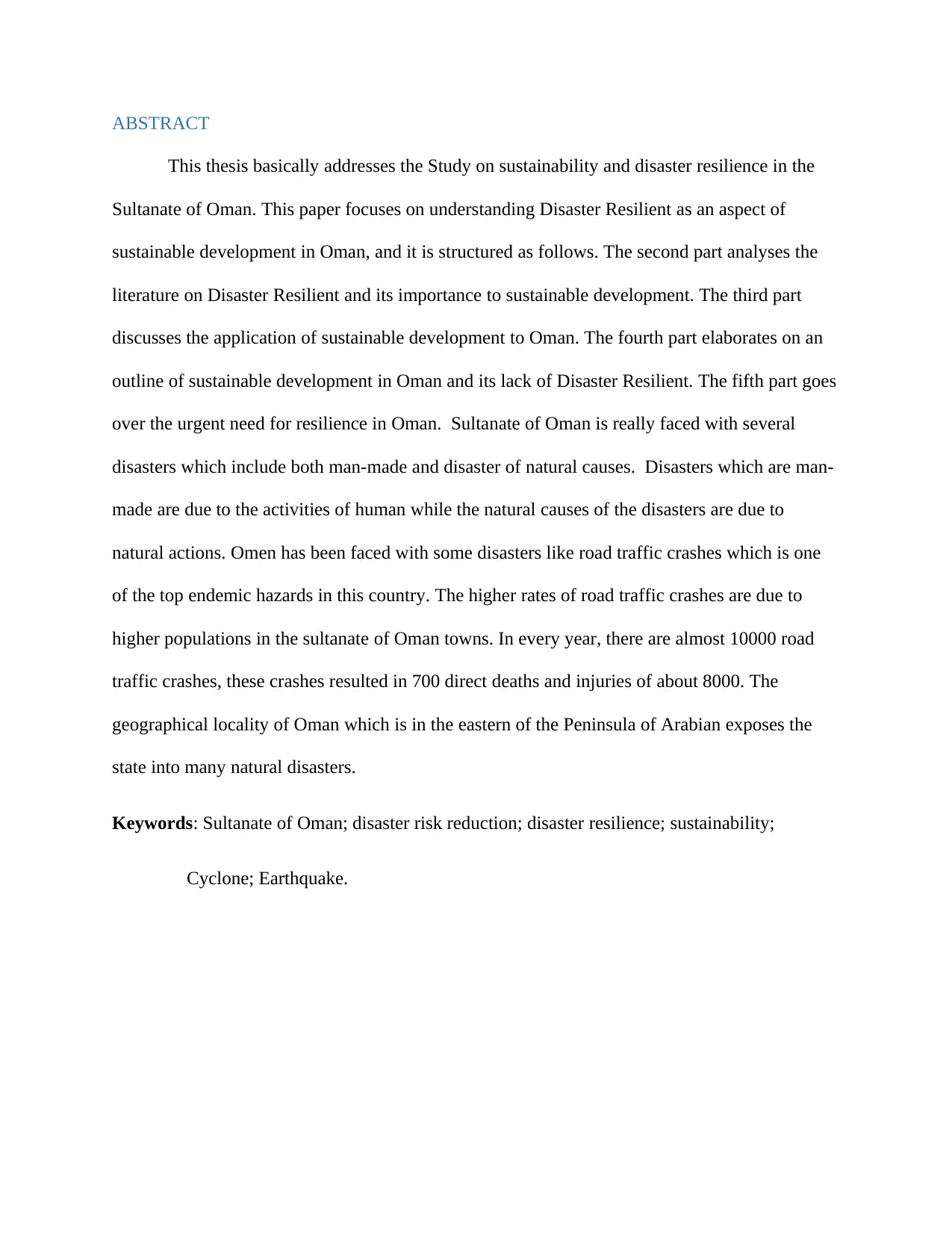
ABSTRACT
This thesis basically addresses the Study on sustainability and disaster resilience in the
Sultanate of Oman. This paper focuses on understanding Disaster Resilient as an aspect of
sustainable development in Oman, and it is structured as follows. The second part analyses the
literature on Disaster Resilient and its importance to sustainable development. The third part
discusses the application of sustainable development to Oman. The fourth part elaborates on an
outline of sustainable development in Oman and its lack of Disaster Resilient. The fifth part goes
over the urgent need for resilience in Oman. Sultanate of Oman is really faced with several
disasters which include both man-made and disaster of natural causes. Disasters which are man-
made are due to the activities of human while the natural causes of the disasters are due to
natural actions. Omen has been faced with some disasters like road traffic crashes which is one
of the top endemic hazards in this country. The higher rates of road traffic crashes are due to
higher populations in the sultanate of Oman towns. In every year, there are almost 10000 road
traffic crashes, these crashes resulted in 700 direct deaths and injuries of about 8000. The
geographical locality of Oman which is in the eastern of the Peninsula of Arabian exposes the
state into many natural disasters.
Keywords: Sultanate of Oman; disaster risk reduction; disaster resilience; sustainability;
Cyclone; Earthquake.
This thesis basically addresses the Study on sustainability and disaster resilience in the
Sultanate of Oman. This paper focuses on understanding Disaster Resilient as an aspect of
sustainable development in Oman, and it is structured as follows. The second part analyses the
literature on Disaster Resilient and its importance to sustainable development. The third part
discusses the application of sustainable development to Oman. The fourth part elaborates on an
outline of sustainable development in Oman and its lack of Disaster Resilient. The fifth part goes
over the urgent need for resilience in Oman. Sultanate of Oman is really faced with several
disasters which include both man-made and disaster of natural causes. Disasters which are man-
made are due to the activities of human while the natural causes of the disasters are due to
natural actions. Omen has been faced with some disasters like road traffic crashes which is one
of the top endemic hazards in this country. The higher rates of road traffic crashes are due to
higher populations in the sultanate of Oman towns. In every year, there are almost 10000 road
traffic crashes, these crashes resulted in 700 direct deaths and injuries of about 8000. The
geographical locality of Oman which is in the eastern of the Peninsula of Arabian exposes the
state into many natural disasters.
Keywords: Sultanate of Oman; disaster risk reduction; disaster resilience; sustainability;
Cyclone; Earthquake.
Paraphrase This Document
Need a fresh take? Get an instant paraphrase of this document with our AI Paraphraser
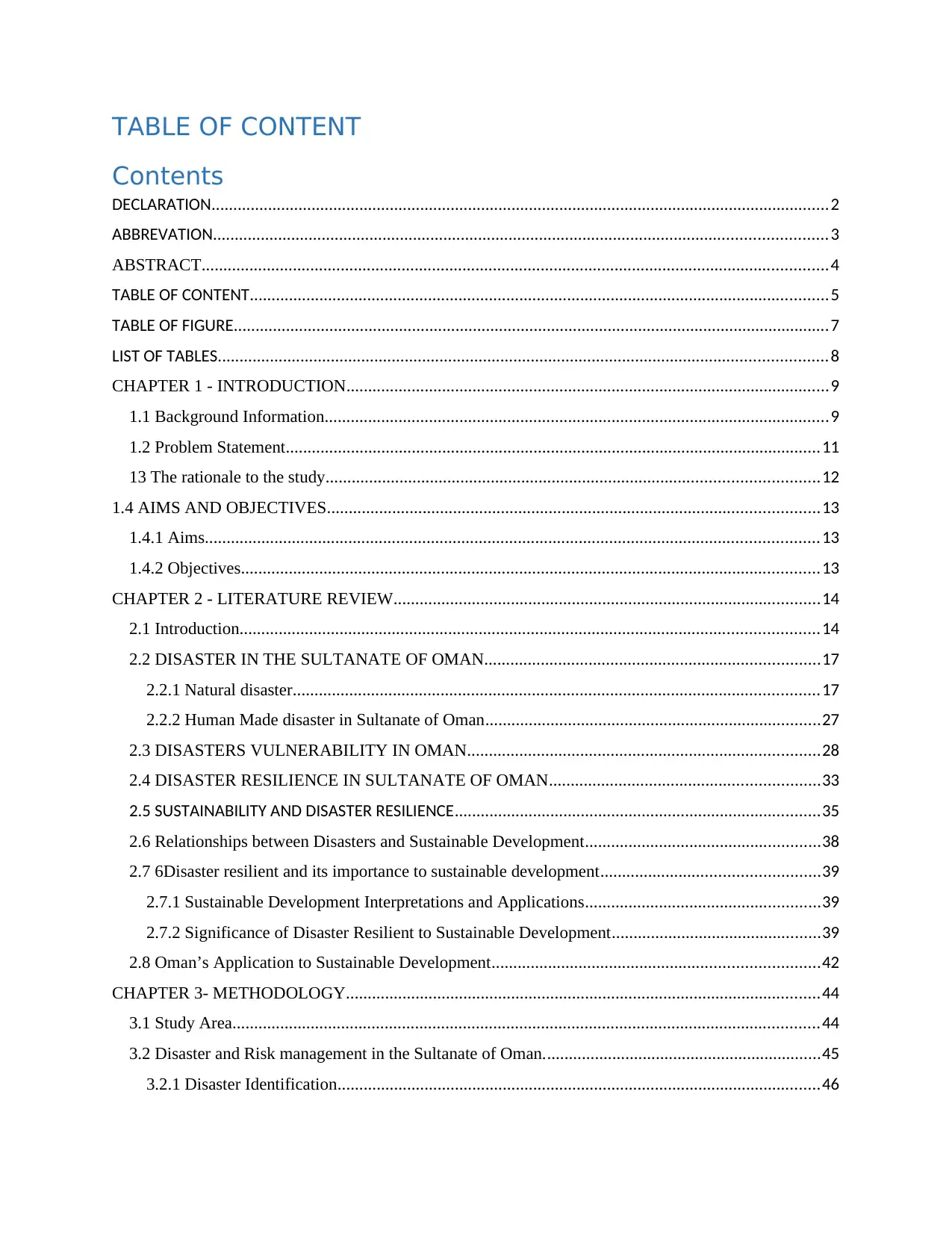
TABLE OF CONTENT
Contents
DECLARATION..............................................................................................................................................2
ABBREVATION.............................................................................................................................................3
ABSTRACT................................................................................................................................................4
TABLE OF CONTENT.....................................................................................................................................5
TABLE OF FIGURE.........................................................................................................................................7
LIST OF TABLES............................................................................................................................................8
CHAPTER 1 - INTRODUCTION...............................................................................................................9
1.1 Background Information....................................................................................................................9
1.2 Problem Statement...........................................................................................................................11
13 The rationale to the study.................................................................................................................12
1.4 AIMS AND OBJECTIVES.................................................................................................................13
1.4.1 Aims.............................................................................................................................................13
1.4.2 Objectives.....................................................................................................................................13
CHAPTER 2 - LITERATURE REVIEW..................................................................................................14
2.1 Introduction.....................................................................................................................................14
2.2 DISASTER IN THE SULTANATE OF OMAN.............................................................................17
2.2.1 Natural disaster.........................................................................................................................17
2.2.2 Human Made disaster in Sultanate of Oman.............................................................................27
2.3 DISASTERS VULNERABILITY IN OMAN.................................................................................28
2.4 DISASTER RESILIENCE IN SULTANATE OF OMAN..............................................................33
2.5 SUSTAINABILITY AND DISASTER RESILIENCE....................................................................................35
2.6 Relationships between Disasters and Sustainable Development......................................................38
2.7 6Disaster resilient and its importance to sustainable development..................................................39
2.7.1 Sustainable Development Interpretations and Applications......................................................39
2.7.2 Significance of Disaster Resilient to Sustainable Development................................................39
2.8 Oman’s Application to Sustainable Development...........................................................................42
CHAPTER 3- METHODOLOGY.............................................................................................................44
3.1 Study Area.......................................................................................................................................44
3.2 Disaster and Risk management in the Sultanate of Oman................................................................45
3.2.1 Disaster Identification...............................................................................................................46
Contents
DECLARATION..............................................................................................................................................2
ABBREVATION.............................................................................................................................................3
ABSTRACT................................................................................................................................................4
TABLE OF CONTENT.....................................................................................................................................5
TABLE OF FIGURE.........................................................................................................................................7
LIST OF TABLES............................................................................................................................................8
CHAPTER 1 - INTRODUCTION...............................................................................................................9
1.1 Background Information....................................................................................................................9
1.2 Problem Statement...........................................................................................................................11
13 The rationale to the study.................................................................................................................12
1.4 AIMS AND OBJECTIVES.................................................................................................................13
1.4.1 Aims.............................................................................................................................................13
1.4.2 Objectives.....................................................................................................................................13
CHAPTER 2 - LITERATURE REVIEW..................................................................................................14
2.1 Introduction.....................................................................................................................................14
2.2 DISASTER IN THE SULTANATE OF OMAN.............................................................................17
2.2.1 Natural disaster.........................................................................................................................17
2.2.2 Human Made disaster in Sultanate of Oman.............................................................................27
2.3 DISASTERS VULNERABILITY IN OMAN.................................................................................28
2.4 DISASTER RESILIENCE IN SULTANATE OF OMAN..............................................................33
2.5 SUSTAINABILITY AND DISASTER RESILIENCE....................................................................................35
2.6 Relationships between Disasters and Sustainable Development......................................................38
2.7 6Disaster resilient and its importance to sustainable development..................................................39
2.7.1 Sustainable Development Interpretations and Applications......................................................39
2.7.2 Significance of Disaster Resilient to Sustainable Development................................................39
2.8 Oman’s Application to Sustainable Development...........................................................................42
CHAPTER 3- METHODOLOGY.............................................................................................................44
3.1 Study Area.......................................................................................................................................44
3.2 Disaster and Risk management in the Sultanate of Oman................................................................45
3.2.1 Disaster Identification...............................................................................................................46
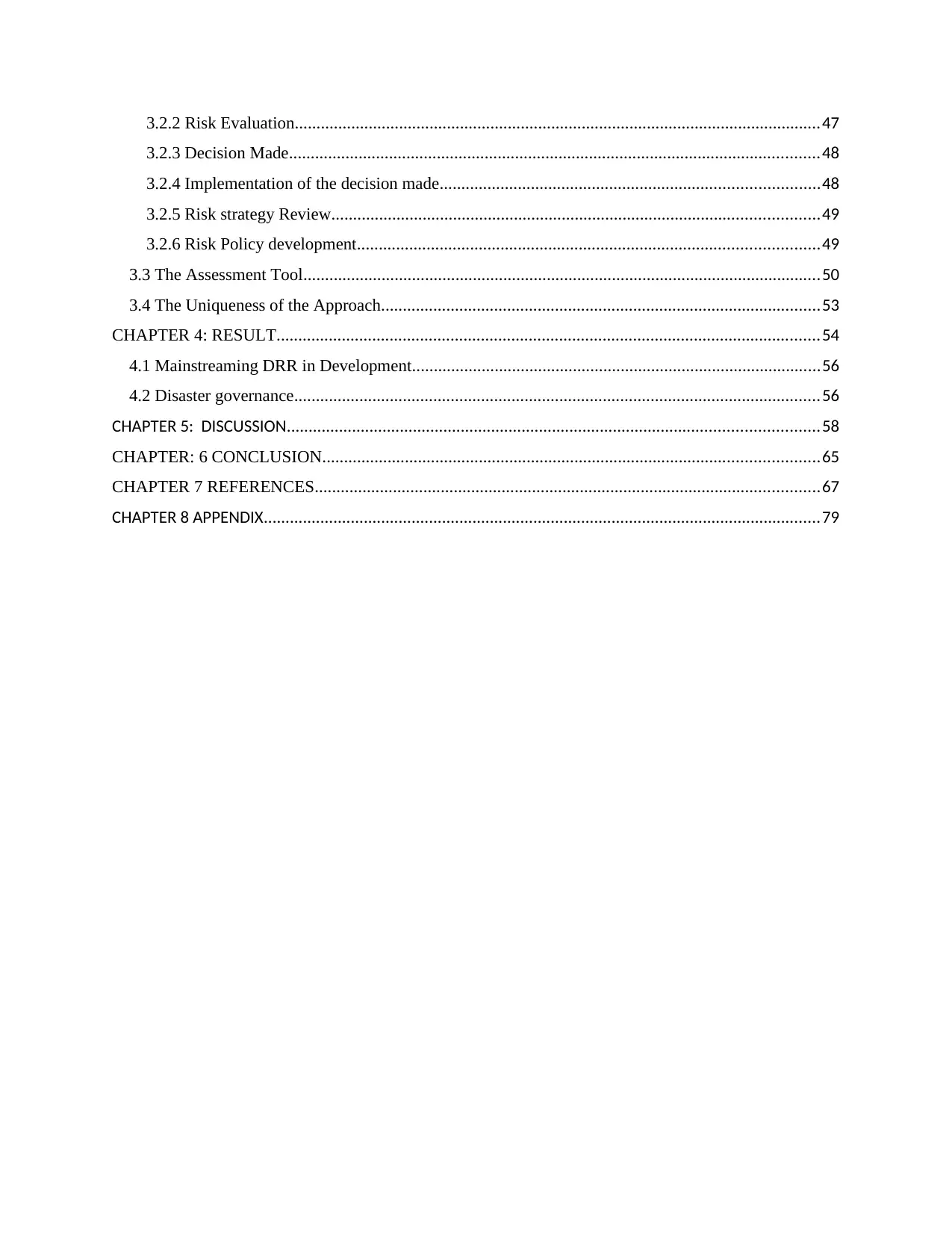
3.2.2 Risk Evaluation.........................................................................................................................47
3.2.3 Decision Made..........................................................................................................................48
3.2.4 Implementation of the decision made.......................................................................................48
3.2.5 Risk strategy Review................................................................................................................49
3.2.6 Risk Policy development..........................................................................................................49
3.3 The Assessment Tool.......................................................................................................................50
3.4 The Uniqueness of the Approach.....................................................................................................53
CHAPTER 4: RESULT.............................................................................................................................54
4.1 Mainstreaming DRR in Development..............................................................................................56
4.2 Disaster governance.........................................................................................................................56
CHAPTER 5: DISCUSSION..........................................................................................................................58
CHAPTER: 6 CONCLUSION..................................................................................................................65
CHAPTER 7 REFERENCES....................................................................................................................67
CHAPTER 8 APPENDIX................................................................................................................................79
3.2.3 Decision Made..........................................................................................................................48
3.2.4 Implementation of the decision made.......................................................................................48
3.2.5 Risk strategy Review................................................................................................................49
3.2.6 Risk Policy development..........................................................................................................49
3.3 The Assessment Tool.......................................................................................................................50
3.4 The Uniqueness of the Approach.....................................................................................................53
CHAPTER 4: RESULT.............................................................................................................................54
4.1 Mainstreaming DRR in Development..............................................................................................56
4.2 Disaster governance.........................................................................................................................56
CHAPTER 5: DISCUSSION..........................................................................................................................58
CHAPTER: 6 CONCLUSION..................................................................................................................65
CHAPTER 7 REFERENCES....................................................................................................................67
CHAPTER 8 APPENDIX................................................................................................................................79
⊘ This is a preview!⊘
Do you want full access?
Subscribe today to unlock all pages.

Trusted by 1+ million students worldwide
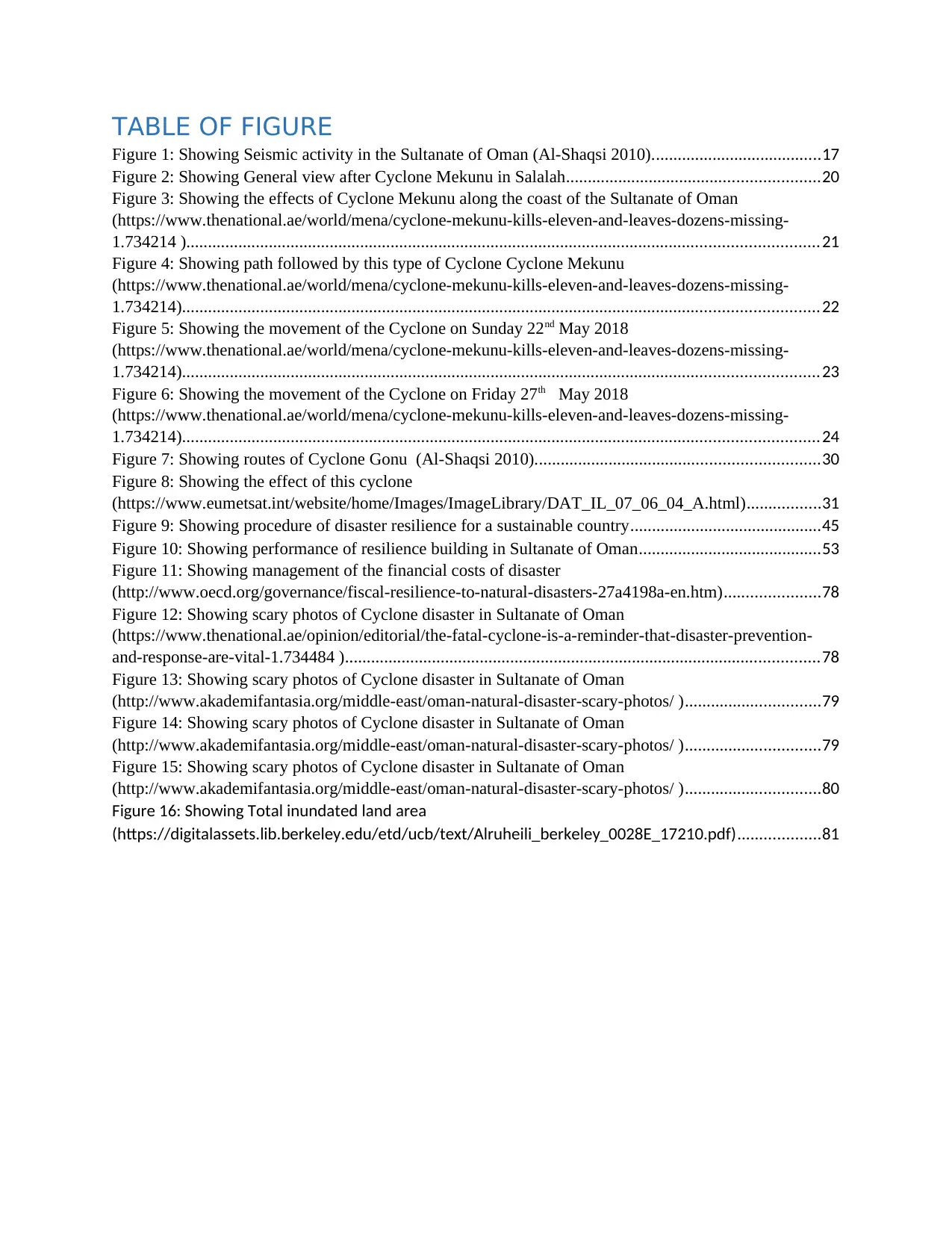
TABLE OF FIGURE
Figure 1: Showing Seismic activity in the Sultanate of Oman (Al-Shaqsi 2010).......................................17
Figure 2: Showing General view after Cyclone Mekunu in Salalah..........................................................20
Figure 3: Showing the effects of Cyclone Mekunu along the coast of the Sultanate of Oman
(https://www.thenational.ae/world/mena/cyclone-mekunu-kills-eleven-and-leaves-dozens-missing-
1.734214 ).................................................................................................................................................21
Figure 4: Showing path followed by this type of Cyclone Cyclone Mekunu
(https://www.thenational.ae/world/mena/cyclone-mekunu-kills-eleven-and-leaves-dozens-missing-
1.734214)..................................................................................................................................................22
Figure 5: Showing the movement of the Cyclone on Sunday 22nd May 2018
(https://www.thenational.ae/world/mena/cyclone-mekunu-kills-eleven-and-leaves-dozens-missing-
1.734214)..................................................................................................................................................23
Figure 6: Showing the movement of the Cyclone on Friday 27th May 2018
(https://www.thenational.ae/world/mena/cyclone-mekunu-kills-eleven-and-leaves-dozens-missing-
1.734214)..................................................................................................................................................24
Figure 7: Showing routes of Cyclone Gonu (Al-Shaqsi 2010).................................................................30
Figure 8: Showing the effect of this cyclone
(https://www.eumetsat.int/website/home/Images/ImageLibrary/DAT_IL_07_06_04_A.html).................31
Figure 9: Showing procedure of disaster resilience for a sustainable country............................................45
Figure 10: Showing performance of resilience building in Sultanate of Oman..........................................53
Figure 11: Showing management of the financial costs of disaster
(http://www.oecd.org/governance/fiscal-resilience-to-natural-disasters-27a4198a-en.htm)......................78
Figure 12: Showing scary photos of Cyclone disaster in Sultanate of Oman
(https://www.thenational.ae/opinion/editorial/the-fatal-cyclone-is-a-reminder-that-disaster-prevention-
and-response-are-vital-1.734484 ).............................................................................................................78
Figure 13: Showing scary photos of Cyclone disaster in Sultanate of Oman
(http://www.akademifantasia.org/middle-east/oman-natural-disaster-scary-photos/ )...............................79
Figure 14: Showing scary photos of Cyclone disaster in Sultanate of Oman
(http://www.akademifantasia.org/middle-east/oman-natural-disaster-scary-photos/ )...............................79
Figure 15: Showing scary photos of Cyclone disaster in Sultanate of Oman
(http://www.akademifantasia.org/middle-east/oman-natural-disaster-scary-photos/ )...............................80
Figure 16: Showing Total inundated land area
(https://digitalassets.lib.berkeley.edu/etd/ucb/text/Alruheili_berkeley_0028E_17210.pdf)...................81
Figure 1: Showing Seismic activity in the Sultanate of Oman (Al-Shaqsi 2010).......................................17
Figure 2: Showing General view after Cyclone Mekunu in Salalah..........................................................20
Figure 3: Showing the effects of Cyclone Mekunu along the coast of the Sultanate of Oman
(https://www.thenational.ae/world/mena/cyclone-mekunu-kills-eleven-and-leaves-dozens-missing-
1.734214 ).................................................................................................................................................21
Figure 4: Showing path followed by this type of Cyclone Cyclone Mekunu
(https://www.thenational.ae/world/mena/cyclone-mekunu-kills-eleven-and-leaves-dozens-missing-
1.734214)..................................................................................................................................................22
Figure 5: Showing the movement of the Cyclone on Sunday 22nd May 2018
(https://www.thenational.ae/world/mena/cyclone-mekunu-kills-eleven-and-leaves-dozens-missing-
1.734214)..................................................................................................................................................23
Figure 6: Showing the movement of the Cyclone on Friday 27th May 2018
(https://www.thenational.ae/world/mena/cyclone-mekunu-kills-eleven-and-leaves-dozens-missing-
1.734214)..................................................................................................................................................24
Figure 7: Showing routes of Cyclone Gonu (Al-Shaqsi 2010).................................................................30
Figure 8: Showing the effect of this cyclone
(https://www.eumetsat.int/website/home/Images/ImageLibrary/DAT_IL_07_06_04_A.html).................31
Figure 9: Showing procedure of disaster resilience for a sustainable country............................................45
Figure 10: Showing performance of resilience building in Sultanate of Oman..........................................53
Figure 11: Showing management of the financial costs of disaster
(http://www.oecd.org/governance/fiscal-resilience-to-natural-disasters-27a4198a-en.htm)......................78
Figure 12: Showing scary photos of Cyclone disaster in Sultanate of Oman
(https://www.thenational.ae/opinion/editorial/the-fatal-cyclone-is-a-reminder-that-disaster-prevention-
and-response-are-vital-1.734484 ).............................................................................................................78
Figure 13: Showing scary photos of Cyclone disaster in Sultanate of Oman
(http://www.akademifantasia.org/middle-east/oman-natural-disaster-scary-photos/ )...............................79
Figure 14: Showing scary photos of Cyclone disaster in Sultanate of Oman
(http://www.akademifantasia.org/middle-east/oman-natural-disaster-scary-photos/ )...............................79
Figure 15: Showing scary photos of Cyclone disaster in Sultanate of Oman
(http://www.akademifantasia.org/middle-east/oman-natural-disaster-scary-photos/ )...............................80
Figure 16: Showing Total inundated land area
(https://digitalassets.lib.berkeley.edu/etd/ucb/text/Alruheili_berkeley_0028E_17210.pdf)...................81
Paraphrase This Document
Need a fresh take? Get an instant paraphrase of this document with our AI Paraphraser
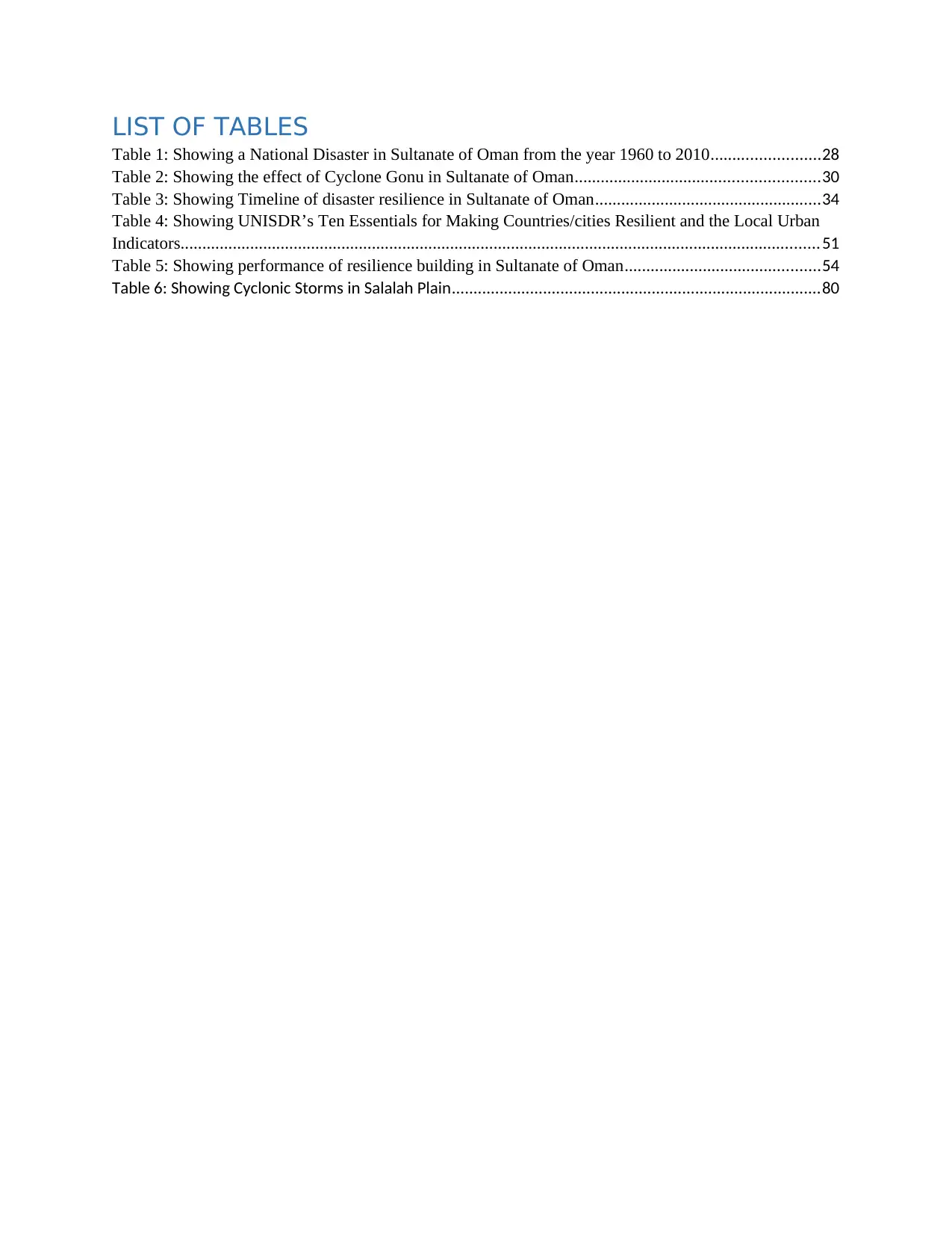
LIST OF TABLES
Table 1: Showing a National Disaster in Sultanate of Oman from the year 1960 to 2010.........................28
Table 2: Showing the effect of Cyclone Gonu in Sultanate of Oman........................................................30
Table 3: Showing Timeline of disaster resilience in Sultanate of Oman....................................................34
Table 4: Showing UNISDR’s Ten Essentials for Making Countries/cities Resilient and the Local Urban
Indicators...................................................................................................................................................51
Table 5: Showing performance of resilience building in Sultanate of Oman.............................................54
Table 6: Showing Cyclonic Storms in Salalah Plain.....................................................................................80
Table 1: Showing a National Disaster in Sultanate of Oman from the year 1960 to 2010.........................28
Table 2: Showing the effect of Cyclone Gonu in Sultanate of Oman........................................................30
Table 3: Showing Timeline of disaster resilience in Sultanate of Oman....................................................34
Table 4: Showing UNISDR’s Ten Essentials for Making Countries/cities Resilient and the Local Urban
Indicators...................................................................................................................................................51
Table 5: Showing performance of resilience building in Sultanate of Oman.............................................54
Table 6: Showing Cyclonic Storms in Salalah Plain.....................................................................................80
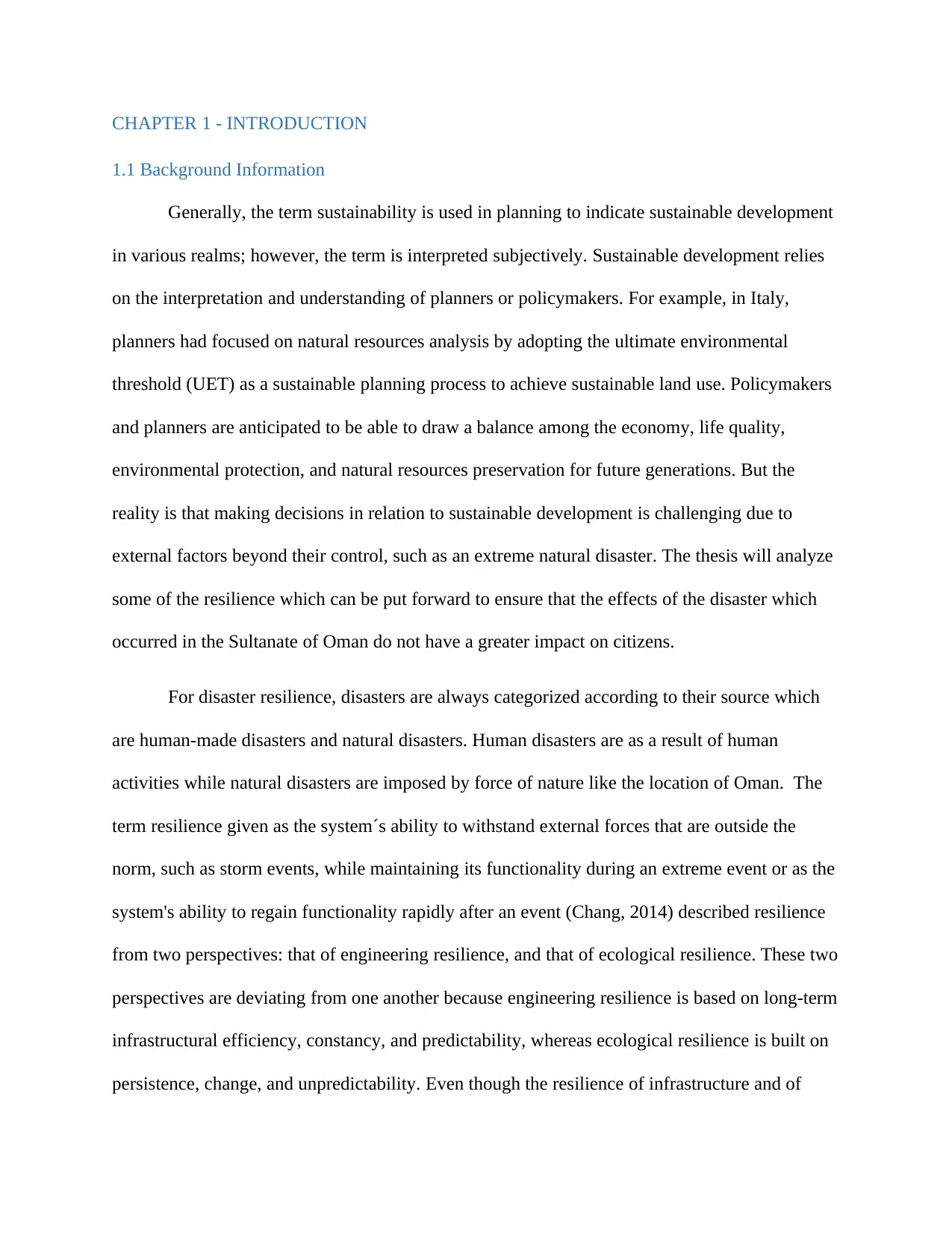
CHAPTER 1 - INTRODUCTION
1.1 Background Information
Generally, the term sustainability is used in planning to indicate sustainable development
in various realms; however, the term is interpreted subjectively. Sustainable development relies
on the interpretation and understanding of planners or policymakers. For example, in Italy,
planners had focused on natural resources analysis by adopting the ultimate environmental
threshold (UET) as a sustainable planning process to achieve sustainable land use. Policymakers
and planners are anticipated to be able to draw a balance among the economy, life quality,
environmental protection, and natural resources preservation for future generations. But the
reality is that making decisions in relation to sustainable development is challenging due to
external factors beyond their control, such as an extreme natural disaster. The thesis will analyze
some of the resilience which can be put forward to ensure that the effects of the disaster which
occurred in the Sultanate of Oman do not have a greater impact on citizens.
For disaster resilience, disasters are always categorized according to their source which
are human-made disasters and natural disasters. Human disasters are as a result of human
activities while natural disasters are imposed by force of nature like the location of Oman. The
term resilience given as the system´s ability to withstand external forces that are outside the
norm, such as storm events, while maintaining its functionality during an extreme event or as the
system's ability to regain functionality rapidly after an event (Chang, 2014) described resilience
from two perspectives: that of engineering resilience, and that of ecological resilience. These two
perspectives are deviating from one another because engineering resilience is based on long-term
infrastructural efficiency, constancy, and predictability, whereas ecological resilience is built on
persistence, change, and unpredictability. Even though the resilience of infrastructure and of
1.1 Background Information
Generally, the term sustainability is used in planning to indicate sustainable development
in various realms; however, the term is interpreted subjectively. Sustainable development relies
on the interpretation and understanding of planners or policymakers. For example, in Italy,
planners had focused on natural resources analysis by adopting the ultimate environmental
threshold (UET) as a sustainable planning process to achieve sustainable land use. Policymakers
and planners are anticipated to be able to draw a balance among the economy, life quality,
environmental protection, and natural resources preservation for future generations. But the
reality is that making decisions in relation to sustainable development is challenging due to
external factors beyond their control, such as an extreme natural disaster. The thesis will analyze
some of the resilience which can be put forward to ensure that the effects of the disaster which
occurred in the Sultanate of Oman do not have a greater impact on citizens.
For disaster resilience, disasters are always categorized according to their source which
are human-made disasters and natural disasters. Human disasters are as a result of human
activities while natural disasters are imposed by force of nature like the location of Oman. The
term resilience given as the system´s ability to withstand external forces that are outside the
norm, such as storm events, while maintaining its functionality during an extreme event or as the
system's ability to regain functionality rapidly after an event (Chang, 2014) described resilience
from two perspectives: that of engineering resilience, and that of ecological resilience. These two
perspectives are deviating from one another because engineering resilience is based on long-term
infrastructural efficiency, constancy, and predictability, whereas ecological resilience is built on
persistence, change, and unpredictability. Even though the resilience of infrastructure and of
⊘ This is a preview!⊘
Do you want full access?
Subscribe today to unlock all pages.

Trusted by 1+ million students worldwide
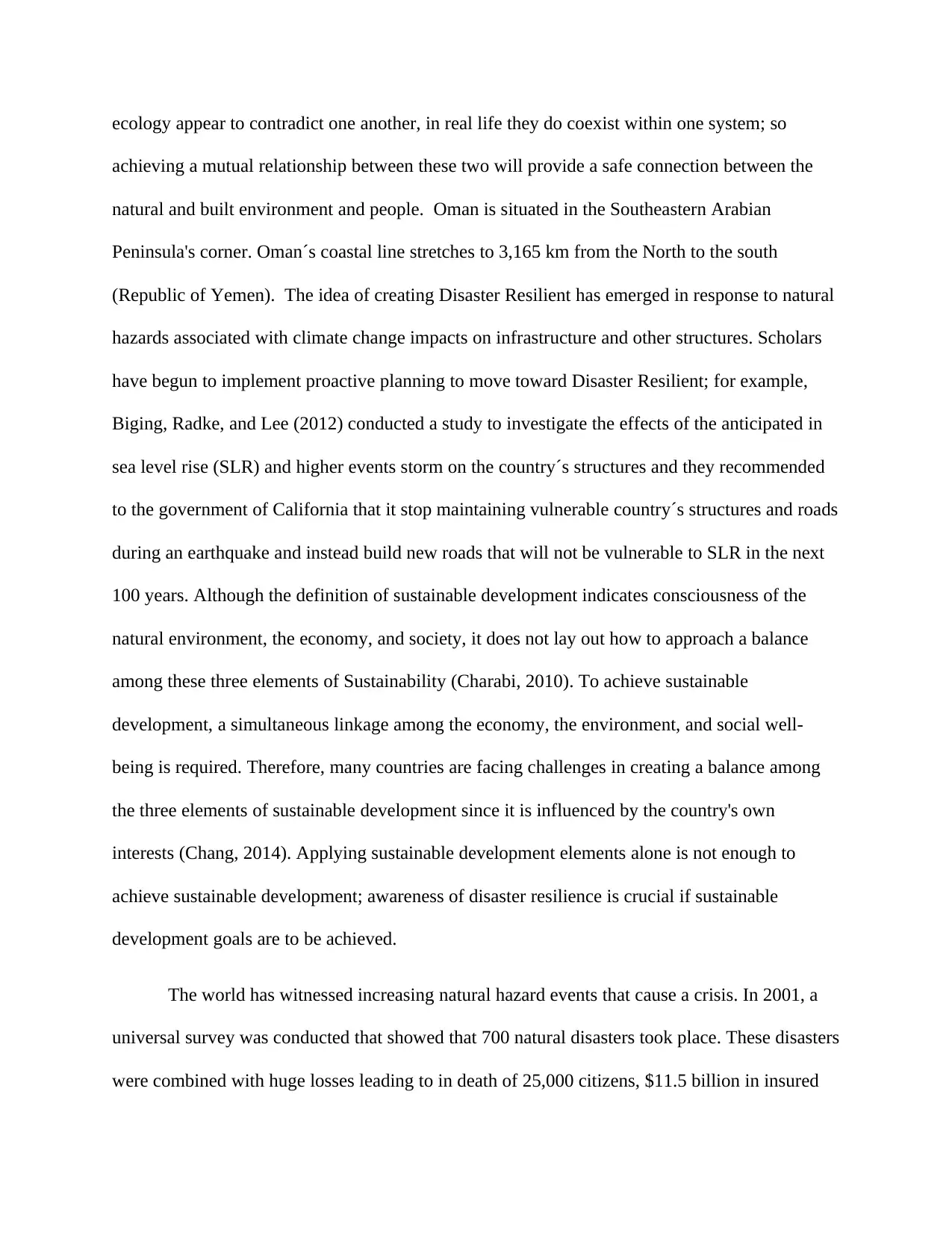
ecology appear to contradict one another, in real life they do coexist within one system; so
achieving a mutual relationship between these two will provide a safe connection between the
natural and built environment and people. Oman is situated in the Southeastern Arabian
Peninsula's corner. Oman´s coastal line stretches to 3,165 km from the North to the south
(Republic of Yemen). The idea of creating Disaster Resilient has emerged in response to natural
hazards associated with climate change impacts on infrastructure and other structures. Scholars
have begun to implement proactive planning to move toward Disaster Resilient; for example,
Biging, Radke, and Lee (2012) conducted a study to investigate the effects of the anticipated in
sea level rise (SLR) and higher events storm on the country´s structures and they recommended
to the government of California that it stop maintaining vulnerable country´s structures and roads
during an earthquake and instead build new roads that will not be vulnerable to SLR in the next
100 years. Although the definition of sustainable development indicates consciousness of the
natural environment, the economy, and society, it does not lay out how to approach a balance
among these three elements of Sustainability (Charabi, 2010). To achieve sustainable
development, a simultaneous linkage among the economy, the environment, and social well-
being is required. Therefore, many countries are facing challenges in creating a balance among
the three elements of sustainable development since it is influenced by the country's own
interests (Chang, 2014). Applying sustainable development elements alone is not enough to
achieve sustainable development; awareness of disaster resilience is crucial if sustainable
development goals are to be achieved.
The world has witnessed increasing natural hazard events that cause a crisis. In 2001, a
universal survey was conducted that showed that 700 natural disasters took place. These disasters
were combined with huge losses leading to in death of 25,000 citizens, $11.5 billion in insured
achieving a mutual relationship between these two will provide a safe connection between the
natural and built environment and people. Oman is situated in the Southeastern Arabian
Peninsula's corner. Oman´s coastal line stretches to 3,165 km from the North to the south
(Republic of Yemen). The idea of creating Disaster Resilient has emerged in response to natural
hazards associated with climate change impacts on infrastructure and other structures. Scholars
have begun to implement proactive planning to move toward Disaster Resilient; for example,
Biging, Radke, and Lee (2012) conducted a study to investigate the effects of the anticipated in
sea level rise (SLR) and higher events storm on the country´s structures and they recommended
to the government of California that it stop maintaining vulnerable country´s structures and roads
during an earthquake and instead build new roads that will not be vulnerable to SLR in the next
100 years. Although the definition of sustainable development indicates consciousness of the
natural environment, the economy, and society, it does not lay out how to approach a balance
among these three elements of Sustainability (Charabi, 2010). To achieve sustainable
development, a simultaneous linkage among the economy, the environment, and social well-
being is required. Therefore, many countries are facing challenges in creating a balance among
the three elements of sustainable development since it is influenced by the country's own
interests (Chang, 2014). Applying sustainable development elements alone is not enough to
achieve sustainable development; awareness of disaster resilience is crucial if sustainable
development goals are to be achieved.
The world has witnessed increasing natural hazard events that cause a crisis. In 2001, a
universal survey was conducted that showed that 700 natural disasters took place. These disasters
were combined with huge losses leading to in death of 25,000 citizens, $11.5 billion in insured
Paraphrase This Document
Need a fresh take? Get an instant paraphrase of this document with our AI Paraphraser
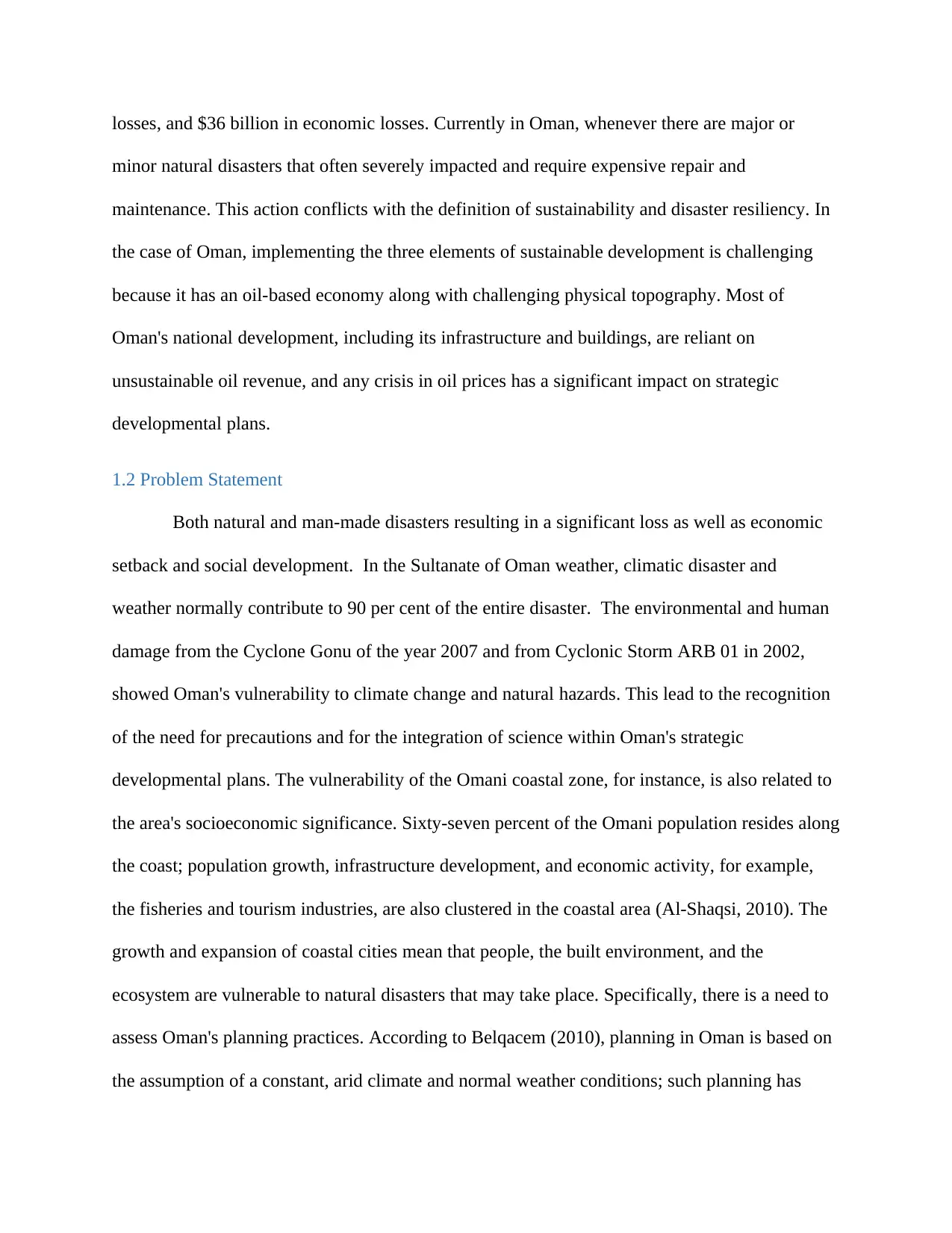
losses, and $36 billion in economic losses. Currently in Oman, whenever there are major or
minor natural disasters that often severely impacted and require expensive repair and
maintenance. This action conflicts with the definition of sustainability and disaster resiliency. In
the case of Oman, implementing the three elements of sustainable development is challenging
because it has an oil-based economy along with challenging physical topography. Most of
Oman's national development, including its infrastructure and buildings, are reliant on
unsustainable oil revenue, and any crisis in oil prices has a significant impact on strategic
developmental plans.
1.2 Problem Statement
Both natural and man-made disasters resulting in a significant loss as well as economic
setback and social development. In the Sultanate of Oman weather, climatic disaster and
weather normally contribute to 90 per cent of the entire disaster. The environmental and human
damage from the Cyclone Gonu of the year 2007 and from Cyclonic Storm ARB 01 in 2002,
showed Oman's vulnerability to climate change and natural hazards. This lead to the recognition
of the need for precautions and for the integration of science within Oman's strategic
developmental plans. The vulnerability of the Omani coastal zone, for instance, is also related to
the area's socioeconomic significance. Sixty-seven percent of the Omani population resides along
the coast; population growth, infrastructure development, and economic activity, for example,
the fisheries and tourism industries, are also clustered in the coastal area (Al-Shaqsi, 2010). The
growth and expansion of coastal cities mean that people, the built environment, and the
ecosystem are vulnerable to natural disasters that may take place. Specifically, there is a need to
assess Oman's planning practices. According to Belqacem (2010), planning in Oman is based on
the assumption of a constant, arid climate and normal weather conditions; such planning has
minor natural disasters that often severely impacted and require expensive repair and
maintenance. This action conflicts with the definition of sustainability and disaster resiliency. In
the case of Oman, implementing the three elements of sustainable development is challenging
because it has an oil-based economy along with challenging physical topography. Most of
Oman's national development, including its infrastructure and buildings, are reliant on
unsustainable oil revenue, and any crisis in oil prices has a significant impact on strategic
developmental plans.
1.2 Problem Statement
Both natural and man-made disasters resulting in a significant loss as well as economic
setback and social development. In the Sultanate of Oman weather, climatic disaster and
weather normally contribute to 90 per cent of the entire disaster. The environmental and human
damage from the Cyclone Gonu of the year 2007 and from Cyclonic Storm ARB 01 in 2002,
showed Oman's vulnerability to climate change and natural hazards. This lead to the recognition
of the need for precautions and for the integration of science within Oman's strategic
developmental plans. The vulnerability of the Omani coastal zone, for instance, is also related to
the area's socioeconomic significance. Sixty-seven percent of the Omani population resides along
the coast; population growth, infrastructure development, and economic activity, for example,
the fisheries and tourism industries, are also clustered in the coastal area (Al-Shaqsi, 2010). The
growth and expansion of coastal cities mean that people, the built environment, and the
ecosystem are vulnerable to natural disasters that may take place. Specifically, there is a need to
assess Oman's planning practices. According to Belqacem (2010), planning in Oman is based on
the assumption of a constant, arid climate and normal weather conditions; such planning has
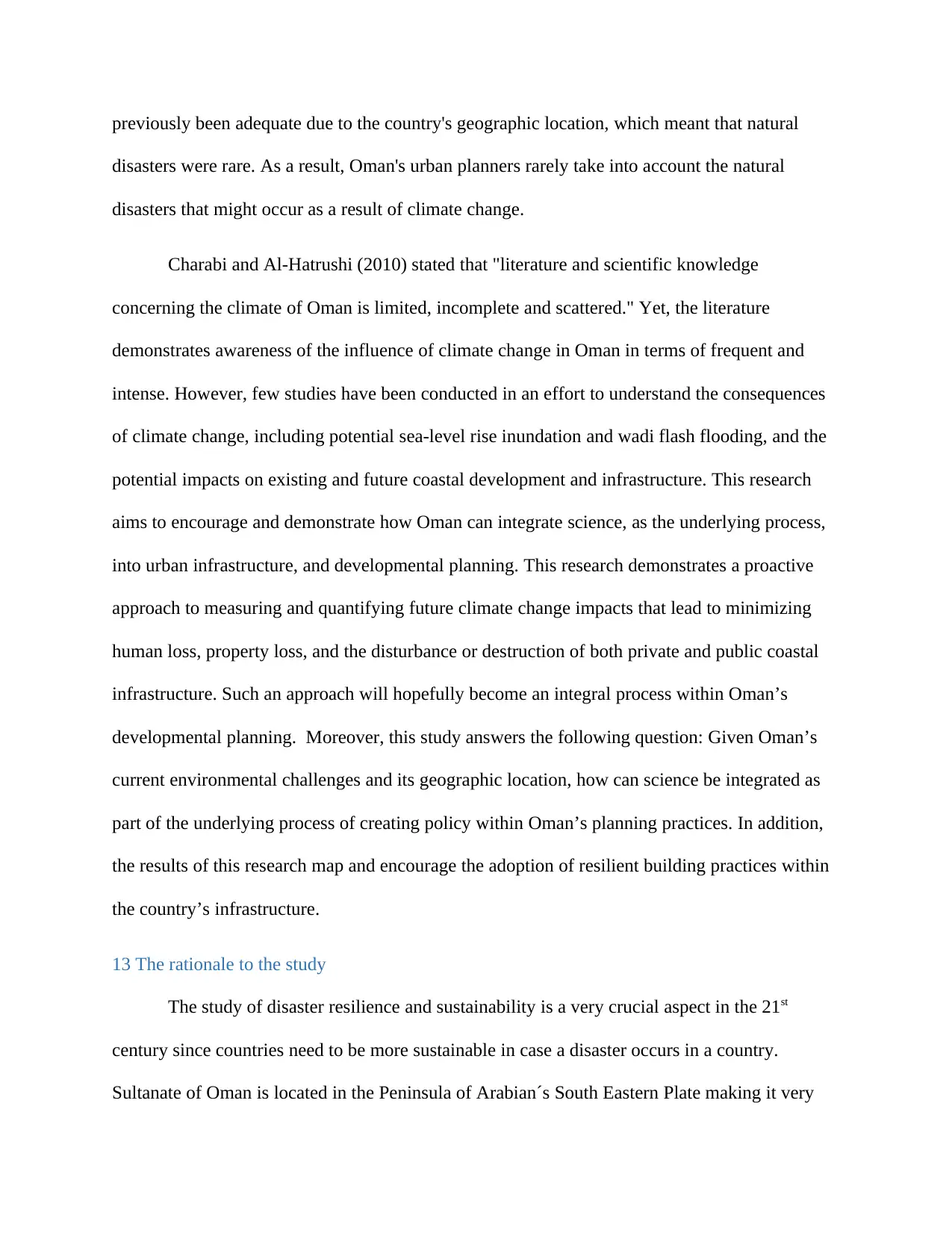
previously been adequate due to the country's geographic location, which meant that natural
disasters were rare. As a result, Oman's urban planners rarely take into account the natural
disasters that might occur as a result of climate change.
Charabi and Al-Hatrushi (2010) stated that "literature and scientific knowledge
concerning the climate of Oman is limited, incomplete and scattered." Yet, the literature
demonstrates awareness of the influence of climate change in Oman in terms of frequent and
intense. However, few studies have been conducted in an effort to understand the consequences
of climate change, including potential sea-level rise inundation and wadi flash flooding, and the
potential impacts on existing and future coastal development and infrastructure. This research
aims to encourage and demonstrate how Oman can integrate science, as the underlying process,
into urban infrastructure, and developmental planning. This research demonstrates a proactive
approach to measuring and quantifying future climate change impacts that lead to minimizing
human loss, property loss, and the disturbance or destruction of both private and public coastal
infrastructure. Such an approach will hopefully become an integral process within Oman’s
developmental planning. Moreover, this study answers the following question: Given Oman’s
current environmental challenges and its geographic location, how can science be integrated as
part of the underlying process of creating policy within Oman’s planning practices. In addition,
the results of this research map and encourage the adoption of resilient building practices within
the country’s infrastructure.
13 The rationale to the study
The study of disaster resilience and sustainability is a very crucial aspect in the 21st
century since countries need to be more sustainable in case a disaster occurs in a country.
Sultanate of Oman is located in the Peninsula of Arabian´s South Eastern Plate making it very
disasters were rare. As a result, Oman's urban planners rarely take into account the natural
disasters that might occur as a result of climate change.
Charabi and Al-Hatrushi (2010) stated that "literature and scientific knowledge
concerning the climate of Oman is limited, incomplete and scattered." Yet, the literature
demonstrates awareness of the influence of climate change in Oman in terms of frequent and
intense. However, few studies have been conducted in an effort to understand the consequences
of climate change, including potential sea-level rise inundation and wadi flash flooding, and the
potential impacts on existing and future coastal development and infrastructure. This research
aims to encourage and demonstrate how Oman can integrate science, as the underlying process,
into urban infrastructure, and developmental planning. This research demonstrates a proactive
approach to measuring and quantifying future climate change impacts that lead to minimizing
human loss, property loss, and the disturbance or destruction of both private and public coastal
infrastructure. Such an approach will hopefully become an integral process within Oman’s
developmental planning. Moreover, this study answers the following question: Given Oman’s
current environmental challenges and its geographic location, how can science be integrated as
part of the underlying process of creating policy within Oman’s planning practices. In addition,
the results of this research map and encourage the adoption of resilient building practices within
the country’s infrastructure.
13 The rationale to the study
The study of disaster resilience and sustainability is a very crucial aspect in the 21st
century since countries need to be more sustainable in case a disaster occurs in a country.
Sultanate of Oman is located in the Peninsula of Arabian´s South Eastern Plate making it very
⊘ This is a preview!⊘
Do you want full access?
Subscribe today to unlock all pages.

Trusted by 1+ million students worldwide
1 out of 80
Your All-in-One AI-Powered Toolkit for Academic Success.
+13062052269
info@desklib.com
Available 24*7 on WhatsApp / Email
![[object Object]](/_next/static/media/star-bottom.7253800d.svg)
Unlock your academic potential
Copyright © 2020–2025 A2Z Services. All Rights Reserved. Developed and managed by ZUCOL.
